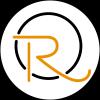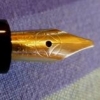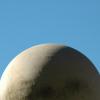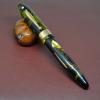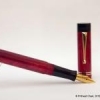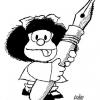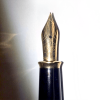Search the Community
Showing results for tags 'ef'.
-
desaturated.thumb.gif.5cb70ef1e977aa313d11eea3616aba7d.gif)
Brief Comparison Of Various Lamy Extra Fine Nibs' Output
A Smug Dill posted a topic in Of Nibs & Tines
These are writing samples using just a single unit of each model of LAMY EF nib I have, without any claim or implication that one unit of (say) Z55 EF nib will be identical or comparable with a different unit of such. The first six nibs were all fitted in turn onto the same feed on the same pen drawing from the same reservoir (i.e. converter) of LAMY Benitoite ink. Each nib was cleaned in a dilute solution of ammonia and detergent and patted dry on a paper towel immediately before fitting on the LAMY cp1 pen used, then pressed against a paper towel until the ink being drawn through is dark enough, then written with on another sheet of Rhodia Dotpad 80g/m² paper until the colour and flow appear stabilised. The last of the nibs listed is the EF nib that came fitted on my LAMY 2000 blue Bauhaus pen. There are discernible but relatively minor differences between the ink flow and output of the first six nibs; the LAMY 2000's EF nib is what stood out as glaringly different, and incidentally I find its output the least pleasing. The first nib is somewhat scratchy, to the point that it ripped and picked up fibres from the paper surface from time to time. I don't suppose every Z50 EF nib is equally as damaging, but I didn't feel like either going through my other Z50 EF nibs to find a better, smoother unit to test, or modifying the nib such that it is significantly different from factory condition (or at least as it was supplied to me by the retailer) by smoothing it with micro-mesh. The Z52 and Z53 nibs are both harder than the Z50 nib, but can put down lines that are at least equally as broad when pressed. The gold nibs feel softer than the steel nibs, and I can physically see more elastic deformation in the body when they are pressed, but their tines don't spread as far apart and thus the "maximum" line widths are not as broad. Even though there has been several reports that the EF nibs on LAMY Dialog 3 pens — which use Z55 nibs — exhibit the characteristic of an architect's grind, in that lines left by downstrokes are narrow and cross-strokes wider, the one I tested proves not every Z55 EF nib is like that. (I have two Z55 EF nibs, but I haven't looked at the other one yet; it's on a new pen that only arrived on the weekend.) The Z57 EF nib tested had more of the Sailor Zoom nib-like quality, in that the incident angle between nib and page changes the line widths of cross-strokes notably. The Lamy 200 EF nib is wettest and broadest of them all, and has the least potential for delivering line variation through hand pressure moderation or fluctuation. Ugh. <EDIT> I just tested another Z50 EF nib, and it was as scratchy as the one used above. Alrighty then, micro-mesh it is. All better now. -
Greetings everyone, I ordinarily only do video reviews but I thought I would give a shot at writing out my feelings about my favorite pen. I was able to purchase a Lamy Aion early because I live in Germany. I have owned my Lamy Aion since Mid August and it is my #1 choice for my EDC. I have broken down my major talking points that I have talked about my video (I will link at the bottom of my text review) Looks (3/10): Overall the looks of the Lamy Aion are very boring. All one color (either black or olive...which is really like a metal color) except for the clip which is a shiny metal. Only subtly does the clip have a small Lamy logo on the side of it. Other than that there are no frills, lines, curves or anything to break up the minimalist looks of this pen. If it were anything that would make me reach for a different pen it would be the looks just because it doesn't inspire anything, it is simply the look of a tool that you are going to use. Construction (10/10): The Aion is constructed of Aluminum. It feels solid in the hand. The aluminum has a brushed finish to it, but the "grooves" are fine enough where you won't feel it in your hands, but if you rub your fingernail from side to side you will be able to file down your nails with it. The body is very resistant to scratches and does not show any finger prints. Cap (9/10): The cap also has the same brushed aluminum finish with no other flair or flashy things on it. This cap is a "pop-cap" and it is removed relatively easily and can easily be removed with one hand. Due to the abrasive nature of the body the cap cannot be "flicked" off with the thumb, but that is probably not the best practice to do anyway. One major flaw is when putting the cap back on; If the cap is not lined up perfectly the lip of the pen will make contact with a ridge inside the cap and completely prevent the pen from going inside the cap. Regardless of how much pressure you put on the misaligned pair neither will budge. While this is not a huge issue, it happens more often than I would care for (especially when trying to cap it while not looking). Clip (10/10):As functional as a clip can get. there is a generous amount of space between the top of the clip and the body of the cap allowing for most clothing to slide underneath without extra effort or careful positioning. The other thing that makes this clip extra functional is there is extra material past the hinging point which allows you to position it between your finger when grabbing the cap to open the clip even further. This is very useful when putting the pen on a loose piece of clothing or on a lanyard or something similar. Grip section (10/10): Both the most comfortable and functional grips that I've owned on a pen. It is fatter than some of my other pens which I really enjoy. I have found that too many pens go to too fine of a point in their grip sections which cramps my hands. I have found that the gradual taper of the Aion is exactly what I find most comfortable. In addition to the shape constructed slightly different than the rest of the body. Instead of it being brushed aluminum, the grip section is "rough" like sea-glass so it is less abrasive than the body and it is very comfortable to hold. It is also extremely grippy. As a daily work horse pen I cannot always control the environment that I use my pen in, sometimes it is hot and my fingers are sweaty or I might need to write something in the middle of me eating lunch. And in every situation even with greasy potato chip fingers I get a firm and confident grip with the Aion. Nib (10/10): I know to some the standard Lamy steel nibs are a great and to some they are bad. To me I think the EF and the F are wonderful for daily writing. Yes, if you are looking for something with a lot of line variation during everyday writing these nibs will not suit your needs, but for a pen that is minimalist and just for function I think these nibs perform perfectly. My EF steel nib is smooth, with very little feed back, it has good flow and it never gives me any hard starts. Another thing about the nib that is great is that you can buy other nibs "cheaply" and swap them out in a matter of seconds, allowing this one pen to serve many functions as long as you don't mind having some inky fingers. Price (9/10): I don't give this a perfect 10/10 not because I don't think the materials/R&D/construction are worth it, but rather it just seems that such a simple pen would likely be slightly cheaper. Or in a trade off have something more interesting about the pen, the pen retails for around USD $70 which is alittle steep especically when you consider it has the same nib as a USD $29 pen. other things to note (not graded): one of the biggest disappointments about this pen is that Lamy did not make it include a self-filling system. When you unscrew the body of the pen the Converter looks so tiny, there is certainly enough room for them to work with to keep the same form and engineer a thin plastic sleeve(prevent it touching metal) with a plunger inside...so please please please if anybody from Lamy is reading this (unlikely, but I can still pray) make a Aion+ version that has an internal piston for greater ink capacity. Conclusion (calculated 8.7/10 || Personal rating 9/10): After using this pen for a solid month, I can confidently say that this pen is my gold standard of what an everyday / work horse pen for rough and turbulent environents like work and school. It is reliable in everyway that you would want it to be. Honestly the only thing I change is add something that would break up mono-tone boring minimalist look. Even adding one fake "turning knob" on the base would add a nice chrome ring which might be nice. but in the end if performance, reliability, and durability is important to you than there really is no better option! Link to my video so you can see the pen in action as well as see what i mean with the pen cap issue: https://youtu.be/NDqdK5Oal5E
-
Schneider BK406 Review Introduction & First Impressions I was looking for a cheap EF pen to dedicate to Baystate Blue and wanted something blue to match the ink. I had been leaning toward getting a blue-capped Pilot Kakuno (F) for this purpose, but when I came across this Schneider pen for less than half the price here in China (under US$5), I thought it was worth a try. I couldn’t find any reviews online for this model and the closest equivalent for sale in the West seems to be Schneider’s Zippy which is still quite different. Schneider makes several inexpensive pens for sale in China that have the same feed and general design as the BK406, but this is one of the few pens in the family that comes with an EF nib, something I felt essential for minimizing BSB’s infamous feathering issue on cheap paper. I was quite underwhelmed when it arrived. It came in a cheap plastic sleeve (see photo below) and had no instructions. Everything about the packaging screamed “disposable ballpoint.” I was still grateful that upon unscrewing the barrel I found a complimentary blue international standard ink cartridge (which I discovered after some testing to be quite waterproof) and a strange empty cartridge inserted into the nipple, perhaps to show the new owner that the pen was cleverly designed to have one cartridge in use and a spare behind it inside the barrel. This is quite clever and explains the length of the pen. Appearance & Design True to its German origin, this pen is as utilitarian as it gets. Everything from the ribs on the cap for ease of removal to the matted section with grip indentations says that this pen is designed for quick and easy use in the trenches of the office or classroom. There are no bells or whistles whatsoever. Even the nib is so plain that all it has on it is an encircled “EF.” If the appearance hadn’t convinced you, the two places where the cap tells you it was made in Germany leave no room for doubt. Like disposable pens, its cap is unfortunately marred by the brand logo and “Schneider Made in Germany” along the side where it can’t be missed. There is a rounded grip section with subtle indentations like is often found on student pens. This section’s matte finish and smooth corners make it quite comfortable to hold and allow for more variation in grip than on something with sharper angles like a Lamy Safari. The flat grooves are even less prominent than on a Pilot Plumix. I was very thankful for this feature because the nib and feed are not aligned with these grips like they usually are on other pens. Since the nib and feed are very tightly in place and appear immovable, I have to disregard the grooves in order to hold the pen the way I usually do. Thankfully, the unobtrusive nature of the grips makes this easy. At first I thought the odd alignment was a quality control issue, but my other Schneider pens have the same alignment, so I suspect it may be some ingenious German design feature. The pen writes perfectly if you hold it according to the grooves, but the alignment just looks odd. Construction & Quality Despite the impression given by the packaging, the BK406 is not a flimsy pen. The plastic barrel and cap have a slightly soft surface (just a little harder than on those disposable Bic ballpoints they have at a bank teller), but the material is thick and looks like it could easily take a beating in a purse or book bag. It feels soft but solid in the hand, certainly more so than similarly priced pens like the Platinum Preppy. Holes at the end prevent the roomy barrel from being used as an eyedropper. The pen has a molded plastic feed which is quite thin and fragile at the tip but seems adequately protected by the rolled steel nib that partly wraps around it. The nib is thick and looks like it could take some tumbles without any repercussions. I used the pen as my daily carry for over a week and it met the floor a few times and survived unscathed. I’m sure you can treat this pen like any cheap ballpoint and expect it to hold up admirably. As for manufacturing, the only flaw I found is the slight misalignment of feed and nib which doesn’t affect writing. The only visible external seam is on the grip section which isn’t really an issue with a pen this cheap and would be covered by one’s hand anyway when in use. Weight & Dimensions Measuring about 14.5cm capped, its length is just between that of a Pilot 78G and a Plumix. This makes it just a little too long to fit neatly in my T-shirt pockets, but a decent fit for the pockets on my dress shirts. It’s too long to fit in the pen pockets of some backpacks and messenger bags. In one bag I tried it stuck so high out of the pen pocket that the clip couldn’t grip the pocket. It measures 13cm uncapped, and 16cm posted, which for my smallish hands means this one is not a poster. Weighing in at 11.6 grams capped/posted and 7.2 grams uncapped, the pen is light and allows for prolonged writing sessions without any fatigue. Writing with it feels like a dream compared to the cramps I was getting from my chunky clunky Jinhao X750. Nib & Performance The BK406 is only available with an extra fine nib, but Schneider makes several similar pens in this price range in fine (e.g., BK400, BK402, Zippi). Some may scoff at using a rolled steel nib, but I find the BK406’s nib to be surprisingly smoother than the dubiously labeled “iridium point” nibs on many of my Chinese pens. It glides across the paper and only gives a little feedback if pressure is applied on rough paper. As can be expected for this price, it’s a true nail with no flexibility whatsoever. The nib and feed work well together to provide perfect flow which I would describe as moderate. I never once experienced skipping or hard starts, although I’ve only tested it with the juicy Baystate Blue and nothing drier. The line is a typical German extra-fine, which becomes somewhere between a Japanese fine and medium when using such a wet ink like BSB. BK406 with Baystate Blue vs. Pilot 78G (F) with Luxury Blue: Filling System & Maintenance The BK406 comes with a single blue Schneider international sized cartridge, but a converter can be purchased separately for nearly the same price as the pen. The converter is great and holds a lot of ink. This pen and converter combination creates a perfect workhorse for extensive writing. Although the pen functions well, it’s regrettable that the nib and feed cannot be removed for cleaning. This inability limits the pen to being used with low-maintenance inks that can be easily washed out or dedicating the pen to just one high-maintenance ink. Cost & Value As far as I know these pens are not available in the States, but here in China they are a little more expensive (32RMB=$4.87) than Chinese pens like the Duke 209 or Hero 359 (both 25RMB=$3.81). The Chinese pens may be better deals because they are often mostly metal and have a removable nib and feed. Nevertheless, I find the nib on the BK406 and other Schneider pens in the same price range to be sturdier and more reliable. For me it’s worth it to pay a little more for an all plastic pen that writes reliably and is more comfortable to use than the cheaper alternatives. Conclusion I’m completely satisfied with this pen and believe I got what I paid for. Although plastic, the BK406 feels sturdier than a lot of lower end Japanese pens that cost much more than it. It isn’t stylish or pretty by any means, but it feels great to write with and suits my needs—an ideal bright blue pen for Baystate Blue (it’s also available in black or white). That being said, I’d never give it to someone as a gift because it lacks eye appeal. If you want an inexpensive and extremely practical pen, this is a great choice.
-
I was on the hunt for a nice Pilot Vanishing Point but my local brick & mortar (Appelboom) doesn't carry Pilot. I mentioned this while picking up some ink for a colleague and was asked if I'd considered the Dialog 3. Well, no, I hadn't. It's considerably more expensive, it's massive, it lacks fancy colour schemes and most of all... it's a Lamy... Sure, I admire the ABC but otherwise no thanks, I'll pass. Lamy and I, we're just not meant to be. Or so I thought... because I fell like a brick for the design, the materials, the amazing engineering, the retractable nib mechanism and the EF nib. When Joost offered me a really good price, that clinched it. "Perfection is not attained when there is nothing more to add. It is attained when there is nothing more to remove." --Antione de Saint Exupéry Design, materials, size, fit and finish This old quote sums up the design of the Dialog 3 quite nicely. Some might see a black cylinder. I see a very attractive, minimalistic design that's modern yet refined at the same time. My matte black version looks like it was chiseled out of rock, then smoothed. The feel of the material reminds me of my Visconti Homo Sapiens Lava Steel (not a bad reference). It's very, very pleasant to the touch and never gives me the feeling of handling plastic. As a result, I love to fondle and twiddle it when not writing. It's a substantial pen to write with because there's no cap that comes off. And it's heavy, by far the heaviest pen in my little collection. Size and weight combined mean that this pen is not for everyone - so try before you buy! I can be brief about quality of engineering, fit and finish: I don't think I've ever held a pen that inspired more confidence than this one. It's like a Mercedes. A fantastic example of Deutsche Gründlichkeit. Rotating the barrel clockwise makes the nib come out and sinks the clip lower onto the barrel (how do they do it...?). It's very addictive to do - it feels so confident somehow. Watching the nib disappear behind its concave hood and seeing the clip rise is truly a thing to behold. Rotating the barrel counterclockwise unscrews the pen and reveals über-engineerd innards with a nice, big converter and the screwed-in, removable nib/feed unit. The nib: architect! The sleek, two-tone design of the nib is a good match to the overall vibe of the pen. The F wrote too wide for me so I requested the EF and was delighted to discover that Lamy chose to grind it as an architect nib! I compared this architect to my old MB 146 EF with 14C nib, which is also a factory-made architect. Both pens write in a very similar way when using straight-up print script (I do not know the proper names of writing styles, sorry) but very different when using cursive: the MB then writes a _much_ wider line. I find the MB EF nib to be slightly more forgiving and pleasant, but the Lamy EF to be more versatile and offering very good control. It's a rigid nib and I cannot detect even a tiny bit of bounce or sag but then again I've never seen a soft architect. As with all architects, it requires attention to keep the writing angle consistent. Tactile response from the writing surface is pronounced but not in the least unpleasant. 90 g/m^2 Oxford paper is a fantastic match; Tomoe is less forgiving, Rhodia is somewhere in the middle. Personally, I love this nib! (For those not acquainted with architect nibs: try before you buy! An architect requires you to maintain a constant writing angle. You might say that you don't move your hand down the page as you write, but you move the page upwards beneath your hand. I adore a good architect, but they're certainly not for everyone.) Ink and wetness Essentially the Dialog 3 is a C/C pen that accommodates either proprietary Lamy cartridges or the included converter. Filling the converter requires unscrewing the barrel, then screwing out the converter/nib/feed unit and dipping that into an ink bottle. When using cartridges, the unit can stay in the pen and you can just remove the cartridge. Ink capacity seems generous, though I did not measure it. Several hours of writing emptied the converter halfway. I inked the pen with Kaweco Midnight Blue, a relatively dry, high-quality ink which can appear black-ish in wet pens but transforms into a transparent, complex, night-sky kind of blue-black in dryer pens. Lamy warns not to flush the Dialog 3 with any kind of detergent, only with water, so I was curious to see how well the pen would perform out of the box. During the first hours, ink flow appeared to be almost perfect. Almost, because it is a trifle inconsistent, gradually varying from slightly dryer to slightly wetter. The complex nature of the ink is pleasantly revealed by this pen. The nib never skips, never hard starts. Endurance, ergonomy and such Despite its weight and size, this pen feels great in my hand and I can write longer sessions with it without fatigue, cramp or any other kind of discomfort. Having said that... if I then switch to a similarly sized pen from another brand, it feels like stepping over from a big, fat Merc S-Class into a Ferrari. My Pilot Justus 95 feels amazingly comfortable after a session with the Dialog 3. It's like being liberated from restraints, it's not subtle... To a lesser extent, the same is true of my Visconti Homo Sapiens Midi. Switching to another pen makes the hand fly over the page. The inevitable comparison to its Japanese counterpart Compared to the Pilot VP, the Dialog 3 is much heavier, girthier, holds much more ink, has a different nib release mechanism, offers less colour schemes, has a retractable clip and is of a more minimalistic, modern design that looks less like a ballpoint and more like a monolith. For the VP, one can buy additional nib/feed units in varying nib sizes. For the Dialog 3, and at a similar price, one can buy additional 14k nibs in varying sizes that easily slip on/off the pen. This basically means that you can buy a VP or a Dialog 3 and use various nib sizes with the same pen, at will. The Lamy is considerably more expensive compared to non-LE VP models, but both the Lamy and the Pilot can be found at (much) reduced prices if one is prepared to make the search effort. Both the Pilot and the Lamy are top-quality pens but personally I'd say that the build quality of the Lamy is even higher than that of the Pilot. In the end, as always, the choice is personal. Conclusion The combination of design, degree of engineering, quality and the architect nib make this pen irresistible to me. It's not just another pen; it really is a instrument of fine writing as well as a fashion statement and a showcase of amazing engineering. I don't think it will make me forget my other pens like the Justus, the HS or some of my vintage pens, but we'll see. Opinions can change over time, which is why this will be an expanding long-term review.
-

Is It Possible To Get A Sailor Pro Gear Slim Mini With An Ef Nib?
Venemo posted a topic in Japan - Asia
I was looking at getting another Japanese fountain pen. I found the Sailor Pro Gear Slim Mini which looks like something my brother would enjoy, he loves small pens with very fine nibs, so I thought I'd get one for him as a present. He is studying Japanese and currently uses a Pilot Elite 95S EF that I gave him when he was accepted to university. However, I was disappointed to see that the Slim Mini is only available with a MF nib. So I wonder, is it possible to find it anywhere with an EF nib? Or if not, is it compatible with any other Sailor pen, so that I could just swap the nibs? Also, how does the MF compare to a normal japanese EF? -
I’ve been happily living in 0.45 - 0.65 line width land for some time now, and have been particularly enjoying the shading I get from soft Ti nibs. Of late I have been having a strong urge to purchase an EF. Digging around I’ve noticed Mr Kelly’s fondness for these, and have noted shading in some of his written examples. Something not seen so much, or so distinctly, in other brands. My question is, do contemporary MB EF nibs exhibit this characteristic? I’m particularly thinking of a Platinum 146. My only current MB experience is with a delightful OB 234.5. I had a 149 forty years ago but gave it away. Thank you for your input.
- 5 replies
-
- montblanc 146
- shading
-
(and 1 more)
Tagged with:
-
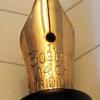
Fine Writing Bronze Age Ef (Expanding Long-Term Review)
TheDutchGuy posted a topic in Fountain Pen Reviews
Context Fine Writing is a Taiwanese company, making mostly high-end pens. Their more affordable pens tend to have striking designs and consist of a series of time-limited models. What's in stores now will not be there forever and what Fine Writing might cook up next is unknown until they release it. There are two earlier Fine Writing reviews here on FPN, as far as I could determine: one for the Bronze Age and one for the Golden Armour. When I first saw photos of the Bronze Age, I knew I had to have one, even though I'd vowed never to buy another pen with a generic Jowo or Bock nib (not that those nibs are inferior, just a matter of personal preference). In other words, this is the first pen that I've ever bought purely because of its design. Packaging, pricing, nib options These pens can be bought in various online stores for prices ranging from €85 ro €99. The nib options are EF, F, M, B and 1.1 mm stub. Nib colours are chrome, gold or black. The pen is packaged in a brown cardboard box and comes with a small booklet, a converter and a pipette. There is no clip. While some may wish for a more lavish box, personally I am happy with the cardboard box. Lavish boxes cost money and I'd rather spend my money on the pen itself. Also, for those who discard boxes, the cardboard can be recycled and is free of plastic and metal. The pen is C/C but can also be eye-droppered, hence the pipette. In eye-dropper mode, the pen holds a HUGE amount of ink, even more than the Opus 88 Demonstrator (which is also an eye-dropper). The converter seems to be identical to the ones that Kaweco uses and appears to be a generic design. Design The design of this pen is striking and I love it, though of course beauty is in the eye of the beholder. The engraved brass cap and filial and the brass section look really nice and the clear acrylic (I assume it is acrylic) barrel make for a unique appearance. The nib is a Jowo #6 engraved with the Fine Writing feather logo. You can unscrew the collar that contains the nib and feed from the pen, which is both easy to do and convenient. I chose an EF. Here are some photos of the various parts of this pen: Dimensions and ergonomy In terms of size, the pen is larger than I'd expected it to be. It's halfway between an Pelikan M800 and an Opus 88 Demonstrator. Below is a picture that compares the Bronze Age to these two pens and to some other pens: a Parker Vacumatic Jr, a Torca, an Onoto #5601, the M800, the Bronze Age, the Opus 88 Demonstrator, an Esterbrook SJ and three Boston pens. Despite its size and appreciable weight, the pen fits my hand very well indeed. To my surprise, it is very comfortable to hold and I can use it for longer periods of time without fatigue. I don't have to search for the right way to hold it. For me, that is quite rare. Only a few of my pens offer me such ease and comfort, though of course this is very personal and subjective. The nib and how it writes Because I prefer narrow lines and an uncluttered, open, clean appearance of text, I chose an EF. That is somewhat of a risk with generic nibs from brands like Jowo and Bock. I've seen many such EF's with asymmetric nib cuts, misaligned tines and other maladies. A good EF, which writes a crisp, narrow line with enough smoothness to be pleasant and comfortable, but also with enough tactile response for good control, that's not easy to do. The F nib on my Opus 88 Demonstrator is also a #6 Jowo and I lucked out with that one - it's a really good steel nib that gives me pleasure every time I use it. So, how well does the EF of the Bronze Age hold up...? Well, pros and cons, really. Proper flow of ink right out of the box, not too dry, not too wet. But it will become a lot wetter once more ink goes out of the barrel and more air comes in (if you don't want that, use a cartridge or a converter). Only a few words of writing were enough to alert me that the tines were not completely aligned. Visual inspection quickly confirmed what my hand had already told me: they were slightly but noticeably misaligned. Something else that I immediately noticed was a certain degree of 'character' to the writing, a very subtle difference in line width between downstrokes, sidestrokes and diagonal strokes. While I adore such an appearance of the written text, in an EF nib it is usually a sign of an asymmetric nib cut and indeed my Bronze Age has such an asymmetric cut (though I have seen much worse). Basically this means that the slit is not in the middle, so one tine is larger than the other. Sometimes the smaller of the two tines is slightly rotated so that the slit is not of equal width from top to bottom. As I mentioned, this is not uncommon and I have seen it on steel nibs from Kaweco, Leonardo (both Bock), Bock itself and Jowo. If you're lucky, the asymmetric cut will add character to your writing without feeling rough, without drag and without flow issues. In this sense I've been lucky several times, but initially the Bronze Age was sub-par. The nib offered good control, had good flow but it just did not feel right. On Rhodia, there was noticeable drag and on all papers that I tested on, some styles of writing just had too much unpleasant feedback, whereas other styles felt smooth. I had to search for a pleasurable writing experience and I don't want to do that - I want the pen to please me, instead of me finding a way to please the pen. Anyway, it took me half a minute to align the tines and another minute to find and remove the minuscule burr that caused the unpleasant feedback. In terms of control, tidiness, character and comfort of writing, the pen immediately became a pleasure to use in every style of writing that I know. Of course, this is a rigid nib and you should not try to flex it in any way. Here are some writing samples on Rhodia, Oxford and Tomoe and a comparison with some other well-known pens: ^--Oxford 90 g/m^2, comparison with Sailor 1911 Standard (M) in top row ^---Tomoe ^--Rhodia ^--Comparison of various other well-known pens Verdict A pen is meant for writing, and the writing is done with the nib, so the business end of a pen has to be really good and really pleasurable. That steel Jowo #6 is the least expensive but most important part of this pen. It required a few interventions on my part to make it do what it is supposed to do, but to be fair many pens using nibs like this require some tuning. Once that was done, wow. The design, execution, comfort, size, ink volume (4 mL!!)... just wow. I can see myself putting in a gold nib at some point in the future, but I did 90 minutes of non-stop writing with the pen and every minute was rewarding, relaxing and enjoyable. The luxury of being able to choose a cartridge, a converter or to eye-dropper it is quite nice. For what this thing costs, you get one helluva pen. I can see myself becoming very attached to this pen very fast. Edit: added additional info on nib removal.- 18 replies
-
- fine writing
- bronze age
-
(and 4 more)
Tagged with:
-
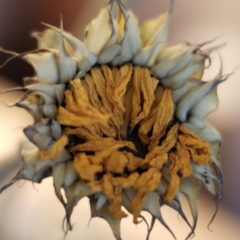
Honeymoon With The Fountain Pen Revolution (Fpr) Flagship: Jaipur V2 With Ultra Flex
peroride posted a topic in Fountain Pen Reviews
Family owned and operated, Fountain Pen Revolution has come out with their version 2 of the Jaipur fountain pen. Currently there are only 2 acrylics, a blue and an orange and 1 ebonite brown which is the subject of this first look reviewlet. What is it? A piston filler of Indian origin designed and branded by FPR along with a stable of other brands that they sell. The ebonite is smoother and finished better than the Himalaya v2. Himalaya looks and feels more matte whilst the Jaipur is slicker and sheenier. The length is a smidge longer and girthier than the Himalaya with a more cylindrical shape. I much prefer its profile over the himalaya v2 and that pen feels almost perfect. Comparison to an M600 would longer, less taper and slight less girth. Jaipur hits close to Lamy Safari dimensions. Left to right: Leonardo Momento Zero, Pelikan M600, FPR Jaipur v2 with Ultra Flex nib, Lamy Vista (clear Safari) and FPR Himalaya V2 The Jaiput v2 piston filler pen can be completely disassembled for maintenance which is a big plus. Additionally the ebonite feed and nib can be swapped for #6 plastic ones at the FPR shop. Takes about one and a half turns to uncap and Jaipur posts deep and secure. I totally love this. The pen is light at 19.5 grams on my coffee scale. How does it feel?Imagine a light Pelikan M800ish/Lamy Safari sized pen with a very slight tapered grip ending at a very clear and useful ink window. Add an ultra flex steel cut out shouldered nib tuned with an ebonite feed backed by unencumbered volume of piston full of ink. Finally, finally I have converted and firsthand witnessed the praise of pleasurable FPR affordable flex writing. I dare say it is up there with 4x more expensive 14K Gold Jowo flex. Unlike my first stutterings with Himalaya v2, Jaipur v2 wrote straight out of the box no problems. No flushing of feeds or heat settings or bum leaky convertors. I just rinsed the nib and .... WTH!! Let's backtrack... I received shipping at work and could not wait to get home to ink the baby up. Everything check out: no defects and superb build quality, piston worky if not a bit stiff. Knock on wood, I got one from the good batch?! then I came home all hot and bothered in the FP heat phase when to my surprise, I could not undo the blind cap. Blind cap? What's that you say? Well unlike a regular piston converter like Montblanc 146, Pelikan M series, Sailor Realo, etc etc FPR Jaipur v2 has a beautifully thin crafted end cap that the user screws to reveal the actual ribbed piston knob. Clockwise knobbing fills and counter will dispense. I could not get the dang thing off and then I heard a rattle sound and saw separation from the piston mechanism and barrel. We were not dealing with a captured converter here. So just before I'm ready to make love with my new pen, i dun brok it?!@ WTH!@#$ No amount of silicone gripper oven mitt strength twisting would undo the blind cap to access the knob for ink filling! I was really upset as I was not sure I was either tightening the blind cap or loosening it. It would not budge and so I had a pen that could not fill unless I syringed from the nib end which unscrews for nib swaps; basically Jaipur as a crappy eyedropper. Then I remembered FPR introductory video and rewatched for the direction of the twists during the Jaipur overview. https://youtu.be/rkX1p47KbM4 I ended up untwisting out the whole piston assembly then I was able to get better purchase on the blind cap and free it to expose the piston knob. But now I had a piston part to reattach. Luckily I was able to rescrew it back in and get the piston working again. I could filler up! Writing, writing and writingJaipur v2 chews ink up and I love it.Finally can go full plow and refill to use up ink stash. Akkerman Garuda Rood - wet juicy yumCrappy De Atramentis Bamboo Green ink sample - feather like crazy but still juicy though had a couple of skips and hard startsDiluted Organic Studio Nitro also sold at FPR - WOW BAM POW! that and Akkerman have been stellar. I dunno maybe it's the piston volume and not that skinny skank convertor of the Himalaya v2 but the Jaipur v2 feels like a homerun on the writing experience. Page after A5 page, I can just gush and pour without issue with the right ink. The only negatives were the super tightening of the blind cap which I did not truly did not over tightened which I "fixed" with silicone grease ?! to the inner threads AND hard to turn, stiff piston which I hope to fix with silicone grease to the ink chamber though I kinda don't want to mess up the honeymoon by unscrewing the nib and potentially ruins it!! In all, Jaipur v2 is a worthy flagship and I prefer it over my 2 Himalaya v2s: 1 good and the other meh . No heat setting, flushing, leaking, etc. I just fill and write now. As a true testament to this pen, I bought another one at the time of this reviewlet, this time in blue acrylic to see if it holds up to this faithful ebonite version. Hey, need more data points? Here's YouTuber Larry of Larry's Fountain Pens with a word: https://youtu.be/Rj2_eDTcSDU Peace out, write on! -
I have a Pilot EF that I think needs a bit of smoothing, but I am scared to death of ruining it. I bought a micro-mesh pad and decided to have a go at a Platinum Preppy that is in a color I don't use. Then I decided since I was already messing around with the pen that I might as well try to eyedropper it, something I have never done before. I used silicone grease and all seemed to be well except later on I noticed some ink spots on my hands, so I think it is leaking somewhere. I do hold my pens fairly close to the nibs. I can't find an o-ring in an appropriate size so I have temporarily added some plumber's tape but that is unsightly and makes it harder to cap the pen. Below is a photo, minus the plumber's tape. I think the smoothing went well but was not excessive, but I still need to come up with a better seal for the eyedropper; I'm trying to work up the courage to smooth out the Pilot EF a bit. The ink is Diamine Oxblood, which I'm testing out and seems quite nice. Do people add a ball to their eyedroppered pens to help keep the ink from drying up?
- 12 replies
-
- japan
- eyedropper
- (and 4 more)
-
I have a Preppy EF which i enjoy writing with. Actually I bought it a few days ago, the black ink which came with it writes so well with the Preppy, but when i refilled it with Sheaffer Skrip Blue, it skipped like hell, nor was the ink flow good when the ink came out (occasionally). I have refilled it with my Quink Black for the time being, well it writes a bit better, but still it writes too dry and the line it writes is too light. Any recommendations for a good ink? (except iroshizoku inks or extremely costly inks)
-
I dropped my pen and transformed my nib (EF) into a crecent shaped mess. I repaired it to a functioning state again, but it's just not the same. There's a slight grind that I can't get rid of. This is a pen that now carries tremendous sentimental value (90%+ graduate exams taken with it, children's birth papers, etc. - I used it for everything!). Yes, I've contacted Lamy and will wait on their verdict. No, I haven't taken it to someone more adept than myself to work on it. Yes, I've scoured the internet for a replacement and found old posts related to the subject (most from 5+ years ago with dead links). Does anyone know where I might be able to find a nib that will work on L2K??? Thanks for your help, Damon
- 31 replies
-
- lamy 2000
- replacement nib
-
(and 2 more)
Tagged with:
-
For those who have 149s with 14k nibs as well as 18k nibs which do you prefer and why? I have a chance to exchange my 149 with a 14k f-m nib for one with an 18k ef nib. I love the finer grind but am wondering if there are any differences that make it worth the exchange.
-
Hello Everyone, i haven't posted here for a while. I have been using just one pen and ink this year. Lamy 2k EF and pelikan smoky quartz. My nib caught on the inner cap and became a little scratchy. I then adjusted the alignment to make smooth. It worked! however now its become very very wet. Has anyone here worked on a Lamy 2k to make it drier and had success. Please post links if you can. thank you!
-
Save 35% off MSRP on Pelikan Extra-Fine (EF) Nib Fountain Pens in Stock at Paper, Ink Pen with discount code extrafine MSRP Regular Price extrafine PriceStresemann M805: $850.00 $680.00 $550.80 M805 & M800: $760.00 $608.00 $492.48 M600: $555.00 $444.00 $359.64 M405: $495.00 $396.00 $320.76 M400: $500.00 $400.00 $324.00 Through Sunday September 9th save on any of our Pelikan Fountain pens in stock with an extra-fine nib. California Resident? We pay your sales tax! Discount is taken during checkout. Please remember to use the discount code: extrafine Stresemann M805: MSRP $850.00 Regular $680.00 extrafine Discount $550.80 M805: MSRP $760.00 Regular $608.00 extrafine Discount $492.48 M800: MSRP $760.00 Regular $608.00 extrafine Discount $492.48M600: MSRP $555.00 Regular $444.00 extrafine Discount $359.64M405: MSRP $495.00 Regular $396.00 extrafine Discount $320.76M400: MSRP $500.00 Regular $400.00 extrafine Discount $324.00 Thanks for looking in. Discount ends at 11:59 pm PDT, Sunday September 9, 2018. Paper, Ink, Pen is an authorized USA dealer of Pelikan fountain pens located in California, USA.
-
Introduction I had always wanted a Bamboo/Sugarcane shaped pen and had stocked up on materials that represent the colour of green and ripened sugarcane material. When fellow FPNer Sanjay Ramaswamy (@Sanjay13leo) got to know of my desire, he proactively reached out to Mr.Kandan of Ranga Pens to commission two pens – one for each of us. I had never dealt with Mr. Kandan before while Sanjay already had their standard bamboo pen. A big thank you to him for having made this pen possible. Design The design of the pen is supposed to mimic a small section of the sugarcane stem. Sugarcane belongs to the grass family Poaceae that also includes bamboo in its lineage. Like Bamboo, sugarcane grows as long, then stems with nodes at regular intervals. The inter-nodal regions of the stem are slightly convex with smooth undulations. In real life, these are stout jointed fibrous stalks that are rich in the sugar sucrose, which accumulates in the stalk internodes. The body of the pen is around 145mm long and mimics two nodes and the stalk area between and around them. One of the nodes is near the top of the cap representing the end finial and the other one in the barrel. The two end finials are characterized by two small holes shaped like simple annular cylinders that represent the hollow stalk between the nodes. All in all, the shape is exactly like a small piece of susutake. As the images will stand testament to, Ranga has managed to deliver exactly what was being sought. This is especially commendable given the blank we had used for getting the ripe sugarcane colour is especially difficult to work on since it is not meant for kitless pens. Ranga however had persevered and despite much pain, managed to deliver a work of art that accurately represents the design brief. http://i1097.photobucket.com/albums/g346/prithwijitchakiPrithwijit/Fountain%20Pen%20Reviews/Ranga%20Sugarcane%20Review/IMGP2034_zpsgfzm31ct.jpg http://i1097.photobucket.com/albums/g346/prithwijitchakiPrithwijit/Fountain%20Pen%20Reviews/Ranga%20Sugarcane%20Review/IMGP2036_zpskl7hzttt.jpg http://i1097.photobucket.com/albums/g346/prithwijitchakiPrithwijit/Fountain%20Pen%20Reviews/Ranga%20Sugarcane%20Review/IMGP2035_zpsec3iuj4n.jpg http://i1097.photobucket.com/albums/g346/prithwijitchakiPrithwijit/Fountain%20Pen%20Reviews/Ranga%20Sugarcane%20Review/IMGP2045_zpsvcqejbms.jpg Size and Balance At 144.5mm capped, this is a regular sized pen. Had it not been for the absence of a clip, it would have fit in squarely into the definition of an EDC (Every Day Carry) pen. There is no metal used anywhere except for the nib and that makes this an incredibly light and comfortable pen to use for extended periods. The weight distribution, the slim section design and the light weight of the polyester briar material all contribute to the comfort. I was initially concerned that the faux node design on the barrel may impact the writing experience, but in real life usage such apprehensions have been soundly negated because the diameter of the barrel even at the thickest point in the node is only 14mm and the smooth undulations don’t even let you feel its presence. Nib Based on my request, Ranga got the pen ready to accept WIN/Jowo #6 nib units. I decided to put on a Dual Tone EF nib unit from WIN/Jowo paired with a Schmidt K5 convertor. The nib was sourced from Mr. Subramaniam of ASApens.in . http://i1097.photobucket.com/albums/g346/prithwijitchakiPrithwijit/Fountain%20Pen%20Reviews/Ranga%20Sugarcane%20Review/IMGP2052_zpsn8mgtwur.jpg http://i1097.photobucket.com/albums/g346/prithwijitchakiPrithwijit/Fountain%20Pen%20Reviews/Ranga%20Sugarcane%20Review/IMGP2054_zpsv9eq8qky.jpg Filling Mechanism It’s a plain vanilla cartridge-convertor system that accepts standard international cartridges and compatible convertors. While it may be vanilla, it remains my favourite flavour for providing the best proposition around value, system longevity, convenience and widespread compatibility. Build Quality To summarize, this pen has impeccable build quality all around with one major flaw or oversight. The seams are well aligned, the threads are smooth and the finish is superlative. The polish on this pen is astounding and beats all expectations. The attention to detail all around is impressive except for the two cylindrical holes at the two ends which have not been polished properly. They still show lathe marks and are an eyesore in an otherwise fabulously finished pen. http://i1097.photobucket.com/albums/g346/prithwijitchakiPrithwijit/Fountain%20Pen%20Reviews/Ranga%20Sugarcane%20Review/IMGP2046_zpsg6nbpu0p.jpg Writing Experience I am normally not an EF nib user. I prefer Medium nibs for the smoothness and larger sweet spot they typically offer. So I may not be the best person to judge an EF nib. I did however find the nib on this pen rather smooth and comfortable to use so long as you use it within its sweet spot. I did in fact like it better than the Hero 100 fine nib or Schmidt fine nib. For the inaugural use, I had loaded the pen with Sheaffer brown ink. Though it doesn’t have the reputation of being a wet ink or a shading ink, I did notice some element of shading in my writings with this nib. So that tells me that it is a fairly wet nib for an EF and that makes me a happy camper. While I won’t become an EF user because of this one time experience, I would not mind using and recommending this nib to others who prefer F / EF nibs. Price and Value The Sugarcane is not yet a standard model for Ranga and there is no standard price for it. The pen was made by Mr. Kandan as a one off special request from Sanjay and myself. The remuneration they took is modest and equivalent to the cost of any of their standard pens. Nib and blanks were sourced by me on my own and costs for these were obviously extra. Overall, I find this great value because not many pen makers sell custom pens at regular pen prices. Specifications Please find below the measurements of the pen made using non precision instruments and approach. Given that these are handmade pens and there are small piece to piece variations anyway, the measurements should give you a fair enough indication of what to expect from the pen. Length (capped) – 144.5 mm Length (uncapped) – 137 mm Length (cap) – 61.5 mm Length (section) – 20 mm Maximum width (Cap) – 14 mm Minimum width (Barrel) – 11.5 mm Maximum section width – 9 mm Minimum section width – 7.5 mm Conclusion To draw a conclusion with regards to this pen is a bit tricky. If I were to look at the pen dispassionately and judge it by its merits and aesthetics alone, the pen looks superb and a definite buy. Ranga has clearly delivered and has created a masterpiece. However, I cannot help but acknowledge the fact that the design is not very different from Ken Carver’s Bamboo design. Once you realise that, then it makes more sense to opt for the original rather than go through the pains of making a custom pen which is not very different from a pre-existing model. There is one final point I wanted to make before I sign off. The material used for this pen is is a new type of poly-resin called Polyester Briar. This was a fairly new type of material for Ranga who did indeed find this a tad tricky material to use especially when using their traditional tools and methods. This was validated by two other independent pen-makers as well. Given these challenges, it’s doubly commendable on behalf of Ranga to have produced such a stunningly beautiful instrument with such a material. I do applaud them for that.
- 68 replies
-
Hi, I write in English, Korean, Japanese and math, so I've always used Japanese EF nibs (Pilot and Platinum). These nibs being so fine, I've found them also prone to inconsistent flow and gunk that happen to get stuck between the tines. Most of the time flushing the pen in warm water fixes it, but sometimes that's not enough. Of course I turn to the all-knowing Google, but most advices I find (in English, at least) seem to be for much thicker tips. Pressing down on the nib to spread the tines apart sounds like kinda stupid to begin with, and it doesn't work with these EF tips because the nib bends before the tines spread, etc. So I turn to here and seek your wisdom how would you fix inconsistent flow for tips so fine that you can't see the gap when you hold it up to a light? (no puns intended in this entire post!)
-
Has anyone tried this? Black body x EF nib is the only option. Comes in gold or silver trim. US$9.00.
-
Hi, The pens I am reviewing today are the latest version of the 78G that Pilot has started selling exclusively in China since early 2017. My husband has a tiny handwriting and his pens 0.3 pens all seemed too thick for the size he was writing in his agenda in. He also likes the least pretentious pens possible in black and even a Metropolitan seemed too flashy for him. Seeing that I have had good experiences with the old 78G B and BB nibs, when I saw the latest 78G+ version comments previously posted on FPN convinced me to try them out. Please check out the following link to see the thread including the comparison between the old and new 78G by Pilot. https://www.fountainpennetwork.com/forum/topic/318931-pilot-78g-the-new-78g/?p=3789104 However, not being sure what my husband would prefer, I bought two pens: a royal blue Fine nib and the black extra fine. Since the EF is pretty much a needle point, he ended up preferring the F and Inwas super happy to keep the EF. The pens really are very simple though quite nice. Contrary to adversement, body and cap of the new version are not more luxurious than the original 78G: - the clip and ring holding it to the pen is thinner and less solid - the plastic used on the body and cap is shinnier but also prone to more scratches - the printed-on rings on the cap are already coming off after two weeks of use whereas the old ones who are still nice and present months Despite this, there are positive aspects to this purchase. The blue color keeps getting comments from all who see it (including strangers who apparently get mesmerized by the royal blue hue of the EF). Plus, there is that EF nib which I am writing with on a daily basis. Please note that I write big and usually love BIG juicy nibs, stubs and italics. I rarely enjoy anything smaller than an European M... yet this EF is quite pleasurable. It has just a tad of feedback and lays a consistent ultra thin line. Using a printed Nib Width Chart, the EF is actually 0.1 mm of fine writing pleasure. It is actually so fine that it helped me finish my notebook with French Laid paper with a much nicer experience than any other pen because for once I was actually writing between the ridges in the paper. Oh and though I am not a fan of the CON-40 converter, it is better than the CON-20 in the sense that at least now I can check my ink level. In the photos, the green and teal pens are my older 78G (B and BB respectively), the black and the blue are the latest 78G+ (in F and EF respectively). As a conclusion: Pro: - New EF needlepoint - Con-40 is better than Con-20 - Currently being made from EF to B - Can easily be bought on Ebay - New colors Cons: - lesser quality - no more B.B. Stub nibs - only made for the Chinese market - actually not that inexpensive to buy when out of China Hope this was useful!
-

Non-Esterbrook Nib Suggestions For An Esterbrook Js And A #16 Silicone Sac Source
1791thinkshop posted a topic in Of Nibs & Tines
I know that there are plenty of threads regarding some issues I'm having with my Estie Lever fill circa '40's (sac not expanding when filling though it's a new one, feed not running properly, etc..), but what I am posting for was some recommendations from you all for an F or EF preferably non-flex nib. I'm already aware that the #1550 (EF) or #1461 (F) can't get the hob done, but a less scratchy EF would be sweet. I've got. Zebra G Comic on it now, but would like to have the option of putting her into my daily carry rotation and I write small so usually carry F/EF. I'd prefer to have an entire unit for her (section, feed, nib). Also, is there a comparable silicone sac that I could fit her with as the silicone had a better fill property because of the former spring of the material over latex)? Andersen Pen for example has listed 14, 15, 17, and 18 1/2 sized silicone sacs, but no 16's... does someone have 16's for an Estie JS? Or can I put a 15 silicone sac on an Estie? I'm sorry if these seem like silly questions. So suggestions for either the nib/unit, silicone sac, and/or sellers would be greatly appreciated and I thank this entire community that helps each other out with rare animosity displayed in the public area. Thank you for your indulgence and I do hope this discussion might be beneficial to many more than just my needs.. I'll edit this with pictures this afternoon because she really is a beauty. S\F, -B- 4 replies
-
- esterbrook
- ef
-
(and 3 more)
Tagged with:
-
I got two montblanc 149 pens that has 18c EF nib. By the way, they both have Grand Canyon Slit. Is it normal state in vintage 149 18c 'ef' nib? Or just my pen's defect? I think this slight grand canyon slit intend to make smooth flow for narrow nib. Tell me what you think about this! Thank you!
- 3 replies
-
- grand canyon slit
- 18c
-
(and 2 more)
Tagged with:
-
Hi Everyone, I have been reading this forum for awhile. I can find great reviews here for what I am really grateful. This time however I have an issue I need help with. My 1st ever fountain pen was a Rotring ArtPen EF nib. Recently the cap falls off & due to its "outfit" I cannot use at everyday's work - on the other hand I really-really love its nib (no wonder - I used it 8+ years only! for writing). Could you please support me what is the size of the nib, or with which pens I could exchange the nib? I tried several EF pens to substitute this nib (Pilot, Hero, Parker) but no luck yet - so it would be great if I could use this one. Thank you pszabi
-
Hi everyone. I'm looking for a good versatile black ink that will work well in an extra fine lamy safari, won't feather on most papers, and dries in a reasonable amount of time (< 10 seconds on copy paper). I am currently using noodler's black, but I find that it takes too long to dry and causes a significant about of nib creep; it also does not seem to completely dry and smears after several hours. Others have said that it is the "blackest black," but I think pelikan 4001 brilliant black is more black than noodlers, but pelikan is drier. I have samples of diamine onyx and jet black, Bernake black, Quink black, pelikan black, Schaffer black, and lamy black. Lamy and pelikan black both are fantastic inks, but don't seem to be dark enough and look gray at times; other inks like Schaffer feather on cheaper paper or aren't a "true black" like onyx that seems like a dark purple. I have yet to try Quink black. Waterproof properties are a plus but aren't too important for me. Thanks in advance. Also, if anyone has used them how does diamine midnight compare to oxford blue?
-
After weeks of deliberation, I finally placed an order for a Pilot Custom Heritage 912 with a Posting nib, ordered from Engeika (no affiliation) also with some Iro Take-Sumi ink. This will be my first $100+ fountain pen. Does anyone have a 912 that they like/dislike? What might be your comments on it? I hope this will be a good pen; I'm quite excited!
-
I have three Lamy Vistas with EF nibs. At first, they all wrote with a nice, fine line, and moderate ink flow. In the last couple weeks, however, the ink flow in ALL THREE has gotten much heavier. Almost as though there was some kind of 'break in period' or something. I'm completely at a loss, but I want the ink flow back the way it used to be! lol I have not changed the inks I am using in each one in months. One is always filled with Noodler's Zhivago, one with Noodler's Red-Black, and one with Noodler's Navy (diluted with a bit of distilled water). I do not think the ink is the issue, since the same pens, with the same inks, were writing much drier just last month. I do not think my writing style is the problem, because they're almost always used in my Hobonichi, and I'm careful not to put pressure on the paper, lest I dent the page beneath. I honestly haven't the slightest idea what would cause this kind of change? I have looked through the forums here, and have not seen anyone with *quite* the same problem (most people want to increase ink flow, or noticed a problem after switching inks). Hoping there are some ideas?
-
I've recently decided to upgrade my fountain pen collection to more investment pens, now that I've experimented enough to know exactly what I like: a crisp Japanese (~0.2-0.3mm) fine, relatively stiff. How is the Carène's EF by comparison? A little bit wider? A lot wider? Would grinding it to the desired width be a good idea?

